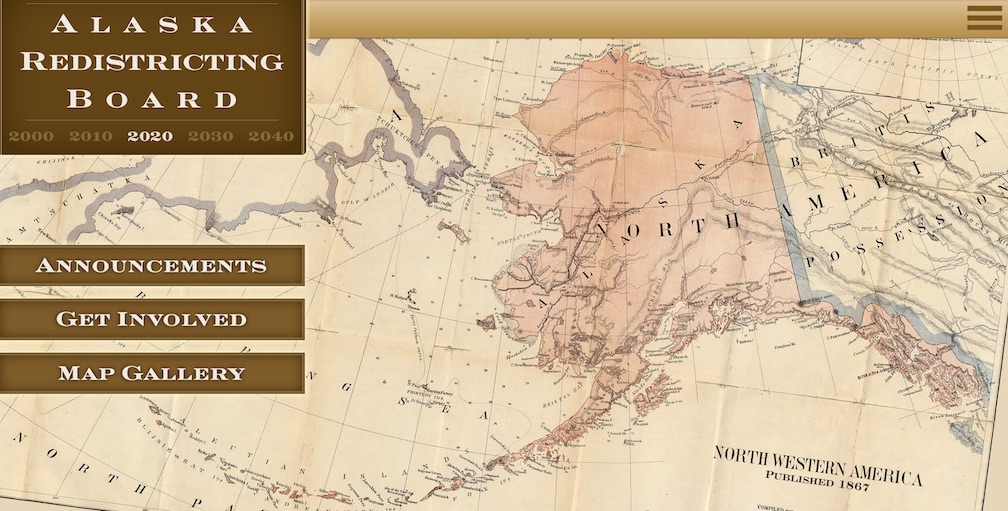The Alaska Redistricting Board has adopted six proposals that will be part of public review and testimony beginning next week.
There are two maps created by the board, and four maps brought forward by third parties, which include:
- Coalition of Doyon, Ltd., Tanana Chiefs Conference, Fairbanks Native Association, Sealaska, and Ahtna, with a map that strengthens Native representation.
- Alaskans for Fair and Equitable Redistricting (AFFER), a group of Republicans.
- Alaskans for Fair Redistricting (AFFR), a group of Democrats.
- The Senate Minority Caucus, Democrats in the Senate.
Today the board heard testimony from various individuals regarding the maps that will create new political boundaries across Alaska:
- Former Sen. Cathy Giessel of Anchorage, a Republican, wants the board to reject the map provided by the Republican group AFFER, at least as the lines pertain to what is now District 31.
- William Stat (sp) of Fairbanks said to be careful drawing lines outside of boroughs.
- Gail Lindemore (sp) said it was not acceptable to move Nikiski on the Kenai to the South Anchorage district.
- Yarrow Silver, a nonpartisan voter, was upset about proposed maps, but like the Democrat maps the best,
- Senators Tom Begich, Jessie Kiehl, and Scott Kawasaki, testifying online, make some changes to their Senate Minority Democrats’ map that incorporates Houston city limits into one district.
- Sen. Tom Begich said he is receiving a lot of questions about decisions made regarding ANCSA regions, and says court precedent states that borough boundaries are more important.
The maps submitted by Alaskans for Fair and Equitable Redistricting took criticism from Board member Nicole Borromeo, who said the Southeast Alaska district lines violate court precedent. The group said it had presented a new map but the board didn’t have it for the meeting.
“We were pleased to hear from Alaskans from every region of the state and replace our initial maps with new and improved versions three and four, which better reflect the socio-economic integration characteristics of each region,” said Board Member Nicole Borromeo, speaking about the two maps offered by the board. “We look forward to hearing feedback from Alaskans on our new draft maps, as well as the four adopted third-party draft maps, as we present them in public meetings in communities across the state.”
The only third party plan that was viewed as unacceptable for the next phase of public review was the one provided by the Alaska Democratic Party. The Republican Party provided no map.
The third parties who provided maps had been making corrections to them since Friday’s public testimony, but that caused a bit of confusion in Monday’s meeting.
Although the maps are not yet available for public review, they will be shortly at this link.
The deadline to adopt a final state legislative map is Nov. 10, 2021.

Tanana chiefs…. I thought it was racist to say chief? Is it or Isn’t it? You decide then let the rest of us know… why do natives think they have a right to land? Countries are conquered all the time.. native Americans faught viciously for land between each other. Why didn’t they do this two hundred years ago when tribes were killing each other trying to access more land?
Looks like someone is worried about Natives having more representation…
When we purchased Alaska from Russia they didn’t have a plan for the tanana chiefs?
Is John Binkley running for Governor again…….as a Republican? ADN would give him favorable, front-page press (color photos too) for the next 415 straight days ??
Binkley is a RINO. His only purpose would be to siphon away conservative votes, allowing Walker to seize control
Giessel is testifying in order draw up redistricting boundaries that will help get Walker elected. Giessel appointed Binkley to the Board while she was still Senate President. Jon Alderson, you may be on to something.
Walker is running for statewide office. Legislative district boundaries have no bearing on that. Perhaps you’re actually thinking of getting legislators elected who will lay down for his agenda?
Good point, Sean. Giessel is probably angling for Commissioner of DHHS if she can help Walker win.
Hey it’s Stapp not Stat
And I was a lot more elegant than that Suzanne
Thanks, I could not hear that correctly, and you were eloquent. – sd
No matter how you draw districts different people are going to be varying degrees of dissatisfied with the results. Apolitical Districting not only eliminates all gerrymandering now and in the future but prevents the aforementioned dissatisfaction from negatively impacting the electoral process.
Apolitical Districting – the primary goal is to guarantee all political interests are prevented from using gerrymandering to subvert individual representation. It would be usable at all levels of government and eliminate the need/expense for any oversight other than algorithm confirmation.
Apolitical Districting relies on the gps data present in the census. Different algorithms could be used with a simple example being 3 concentric circles dividing a local, state or national area into 3 equally populated zones with each zone being “pie sliced” into sub-zones when the applicable number of voters is reached.
Specific to State of Alaska laws there will be cases(likely limited) where apolitical districting could be argued to violate the “as nearly as practicable a relatively integrated socio-economic area”. To that specific law and other similar ones I would argue that socio-economic grouping tends to foster class distinctions, tribalism and impedes legislative cooperation in their primary function of keeping laws fair and updated for everyone.
In my opinion, the benefit of eliminating the possibility of gerrymandering of all degrees now and in the future far outweigh all other objections that will be raised with any districting scheme including this one.
Comments are closed.